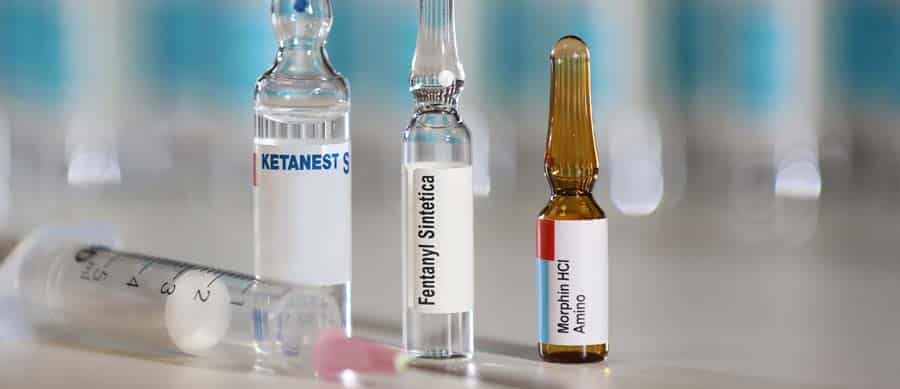About 9.9 million Americans misused prescription pain relievers like morphine in 2018 and widespread morphine addiction and other opioid use disorders are more common than you might think.1
If someone you know is displaying signs of morphine addiction, it’s absolutely essential that he or she gets treatment right away. Morphine addiction can quickly take over someone’s life and cause serious physical and psychological harm. However, all hope is not lost. The right morphine treatment can provide hope and healing with a new sober life.
Before you can help a loved one suffering from morphine addiction, here’s what you need to know about morphine, how morphine addiction works, and morphine treatment options like medical detox, residential rehab, IOP, and sober living.
Table of contents
- What Is Morphine?
- Is Morphine Addictive?
- Morphine Classification: Is Morphine An Opiate?
- What Are the Immediate Side Effects of Morphine Abuse?
- Dangerous Morphine Drug Combinations
- What Are the Signs and Symptoms of Morphine Addiction?
- How Long Does Morphine Stay In Your System?
- Hosting An Intervention for Morphine Addiction
- Morphine Withdrawal Symptoms, Detox, and Treatment Options
- Help Your Loved One Enroll In a Morphine DetoxProgram
What Is Morphine?
Morphine is a non-synthetic narcotic (opioid medication) that is made from opium. It’s a naturally-occurring substance that is extracted from the opium poppy plant and is chemically similar to heroin.
Doctors prescribe morphine to relieve moderate, severe, and chronic pain. It’s available in several different forms, including a tablet, syrup, or injection. Morphine is also used to treat pain relief after major surgeries and for cancer-related pain.
Like other narcotics, morphine works to relieve pain by affecting the central nervous system and the brain. It blocks pain signals to the rest of the body and reduces the stress and anxiety that people feel when they experience physical pain. It also decreases hunger and inhibits the coughing reflex.
Several other drugs cause similar effects, such as codeine, heroin, methadone, hydrocodone, fentanyl, and oxycodone. Morphine is marketed under generic and brand name products including:
- MS-Contin
- MSIR
- Roxanol
- Oramorph SR
- Kadian
- RMS
Is Morphine Addictive?
Yes, morphine is highly addictive. In the United States, it is federally classified as a Schedule II controlled substance, which means it has a high potential for tolerance, abuse, and addiction. It is fairly easy to get and also causes some pleasurable effects, such as euphoria and an overall sense of well-being. These factors can contribute to its addictiveness and a person’s likelihood of developing a morphine addiction.
Morphine Classification: Is Morphine An Opiate?
Yes, morphine is an opiate. Like other opioid drugs, using morphine can cause people to feel happy, relaxed, or high. Not surprisingly, chronic opioid use comes with many risks, even if the drug was initially prescribed by a doctor for medical reasons.
Regular use of morphine can increase a person’s tolerance and dependence, which, in turn, will make them need higher and more frequent doses of it. Taking higher, more frequent doses of morphine can also increase a person’s risk of experiencing slow, shallow breathing, or an opioid overdose.
Often, long-term use of narcotics like morphine also leads to opioid use disorder, which is the official clinical term for opioid addiction.
What Are the Immediate Side Effects of Morphine Abuse?
Someone who is abusing morphine will experience side effects within 15 minutes to an hour of taking a dose. These effects can last up to 6 hours, but it depends on how the person used morphine (crushing a pill, injecting, etc.) and how much they took.
Immediate side effects of morphine usually include:2
- Slowed breathing
- Drowsiness
- Itchy skin
- Nausea
- Inability to concentrate
- Dizziness
- Hallucinations
- Unusual sense of well-being, calm, and relaxation
- Nervousness
- Sleepiness
- Euphoria
- Dry mouth
- Sudden mood changes
- Chest pain
- Apathy
Someone who abuses morphine for an extended time might also experience some long-term side effects, like:
- Depression
- Constipation
- Collapsed veins
- Mental confusion
- Suppressed immune system
Dangerous Morphine Drug Combinations
When it’s used with other medications, illegal drugs, or alcohol, morphine can be especially dangerous and may produce life-threatening side effects. Some common morphine drug combinations include morphine and alcohol and morphine and benzodiazepines. Using morphine with these other addictive substances can cause:
- Dangerous levels of sedation
- Breathing problems or respiratory failure
- Coma
- Death
What Are the Signs and Symptoms of Morphine Addiction?
If your loved one is abusing morphine, you may notice some odd behaviors or side effects. Common side effects and symptoms of morphine abuse to watch for include:
- Nodding off due to unusual sleepiness or drowsiness
- Unusual sense of well-being/happiness
- Dilated pupils
- Slurred speech
- Unusual irritability
- Mood swings
- Legal problems
- Money problems
- “Doctor shopping” for morphine prescriptions
Someone who is struggling with morphine addiction may also:
- Experience morphine withdrawal symptoms when they stop using it
- Try to stop using morphine but be unable to
- Feel like they need morphine to function normally
- Prioritize morphine use over personal and professional obligations
- Use more morphine than intended
- Isolate from friends and family
People who abuse morphine also commonly refer to it by one of its street names to disguise their discussion. Common morphine slang terms include:3
- Dreamer
- Emsel
- First line
- God’s drug
- Hows
- M.S.
- Mister Blue
- Morf
- Morpho
- Unkie
Unfortunately, it is often very difficult to detect morphine abuse, especially if the person misusing it has a prescription. However, if you are concerned, there is likely a reason, and it’s a good idea to be mindful and watch for possible signs.
How Long Does Morphine Stay In Your System?
If you plan on drug testing someone due to concerns that he or she may be abusing morphine, it’s helpful to know how long morphine stays in your system.
Although the effects of morphine will wear off about 4 to 6 hours after taking it, the drug stays in your body much longer. One way to determine how long a drug stays in your system is to measure its half-life, which is the amount of time it takes your body to eliminate half of the drug.
Morphine’s average half-life is 2 to 4 hours, which means it takes your body about 2 to 4 hours to eliminate half of the dose of morphine.4 Since every person metabolizes drugs differently, the half-life will vary slightly from person to person. In other words, it’s not an exact science. However, in most cases, morphine has fully cleared a person’s blood about 12 hours after taking a dose.
Drug test detection times will vary, depending on what type of drug test you use. But morphine can be detected in:5
- saliva for up to 4 days after a person’s last dose
- urine for up to 3 days after a person’s last dose
- hair for up to 90 days after a person’s last dose
Hosting An Intervention for Morphine Addiction
Often, when someone is suffering from morphine addiction, they don’t realize how dire the situation has become. Denial is a common problem. Fortunately, when a friend or family member suggests morphine treatment in a loving, compassionate, and understanding way, the addicted person may be willing to give it a try.
Talking about addiction is often challenging, but staging a morphine addiction intervention is a great way to respectfully express your concern and show your loved one that you care. When an addiction intervention is staged in the right way, a person is less likely to feel like they’re being attacked. Instead, the goal is to show them that many people care for their well-being and that they have the support and help to get sober if they choose to do so.
Staging a morphine addiction is difficult, especially if you’ve never done it before. So, if you’re wondering how to do an intervention, you’re not alone. A professional interventionist can help you plan and stage the intervention so that it is more likely to yield positive results and get your loved one into a morphine rehab program.
The professional team at Briarwood Detox Center can provide intervention assistance and connect you with a referral for an interventionist that we trust. When matching you with an experienced interventionist, we will also consider your loved one’s needs, circumstances, and financial ability to ensure that he or she can get the proper treatment needed for a full recovery.
Morphine Withdrawal Symptoms, Detox, and Treatment Options
If you’re loved one agrees to go to treatment for morphine addiction, the first stage is often morphine detox. If your loved one is severely addicted to morphine, he or she will experience morphine withdrawal symptoms when they suddenly stop using it.
Morphine withdrawal symptoms include:6
- Agitation
- Anxiety
- Muscle aches
- Increased tearing
- Insomnia
- Runny nose
- Sweating
- Yawning
- Abdominal cramping
- Diarrhea
- Dilated pupils
- Goosebumps
- Nausea
- Vomiting
Morphine withdrawal can be very uncomfortable, so it’s best to detox with a medical detox program that provides clinical and medical treatment for withdrawal symptoms. A morphine detox program will also greatly reduce your loved one’s risk of relapse during this early stage of sobriety.
During morphine detox at Briarwood, we provide medication-assisted modalities, individual therapy, group therapy, and family support to guide your loved one through morphine withdrawal. They will also have the opportunity to participate in therapeutic music and art activities and attend H&I meetings, which will provide a welcoming introduction to the 12-Step Program in a low-pressure environment.
After morphine detox, an ideal morphine treatment program may include residential rehab, outpatient rehab, or online IOP. The type of morphine rehab your loved one chooses will likely depend on his or her treatment needs, personal preferences, and financial ability.
Different types of morphine rehab programs provide varying levels of structure too, so it’s best to consult with an addiction treatment professional who can provide recommendations based on your loved one’s substance abuse history, treatment history, and the severity of their addiction.
Following morphine rehab, your loved one may also choose to enroll in a sober living program, which will provide a safe, sober, and supportive group living environment. Many sober living programs also offer recovery support services, such as:
- Regular drug testing
- Structured programming
- Peer recovery support programming
- Employment assistance
- Volunteer placement
- Educational assistance
Help Your Loved One Enroll In a Morphine DetoxProgram
If you’re ready to take action and help your loved one enroll in a morphine detox program, a well-planned intervention is likely a great place to start.
Call Briarwood Detox Center today at (888) 857-0557 to speak with a helpful member of our admissions team about morphine detox. We can also help you determine the extent of your loved one’s insurance coverage for drug detox services or explore alternative payment options.
References:
- https://www.samhsa.gov/data/sites/default/files/cbhsq-reports/NSDUHNationalFindingsReport2018/NSDUHNationalFindingsReport2018.pdf
- https://medlineplus.gov/druginfo/meds/a682133.html
- https://www.dea.gov/sites/default/files/2020-06/Morphine-2020.pdf
- https://www.aruplab.com/files/resources/pain-management/DrugAnalytesPlasmaUrine.pdf
- https://www.mayocliniclabs.com/test-info/drug-book/opiates.html
- https://medlineplus.gov/ency/article/000949.htm


